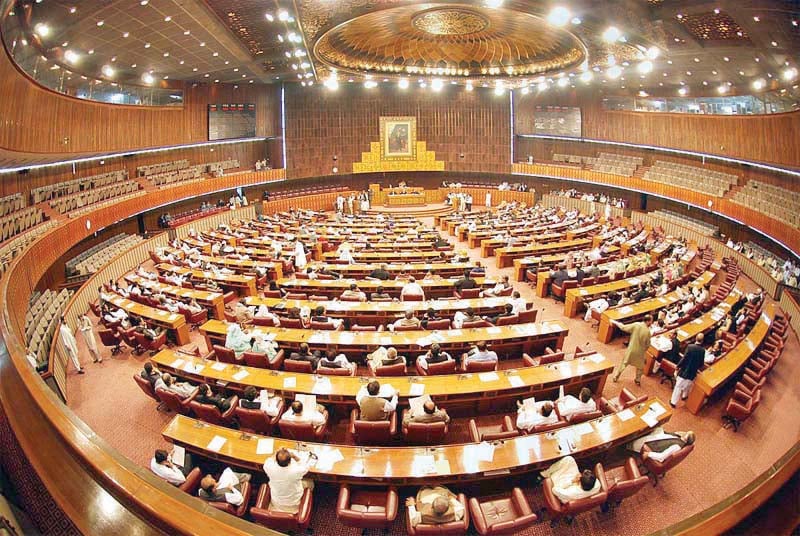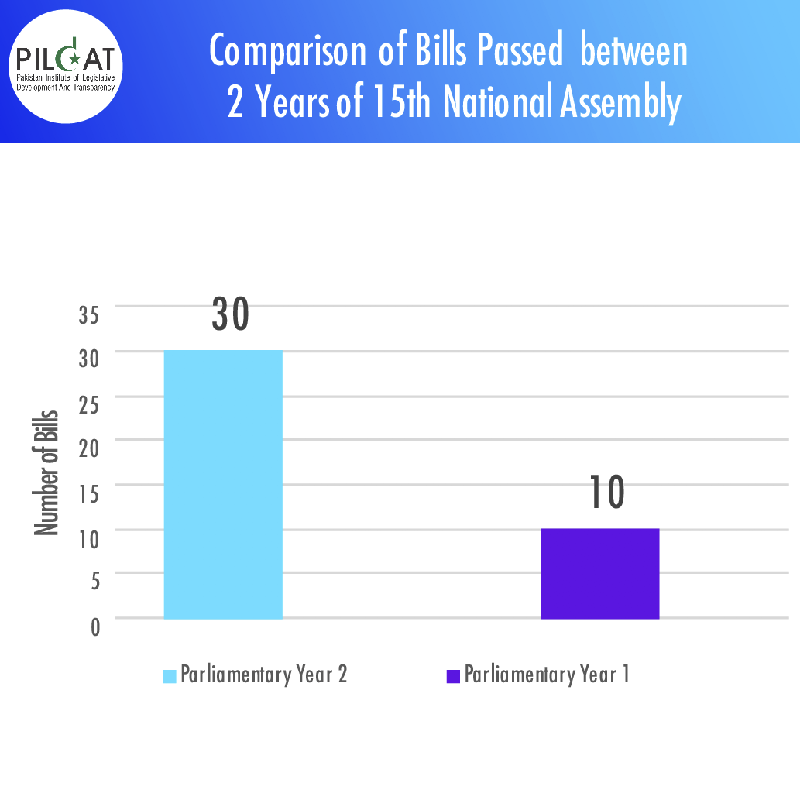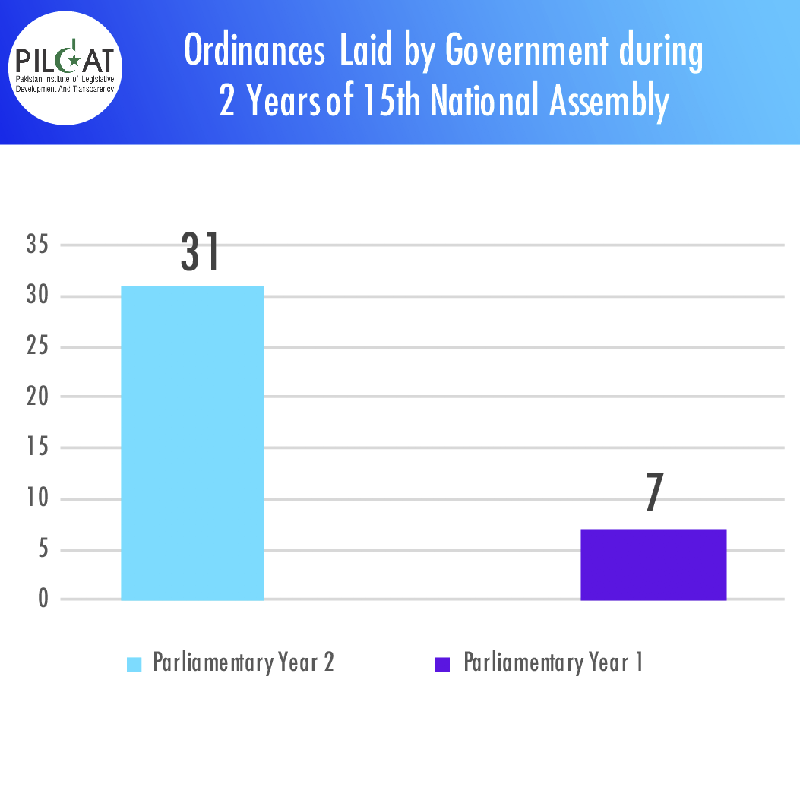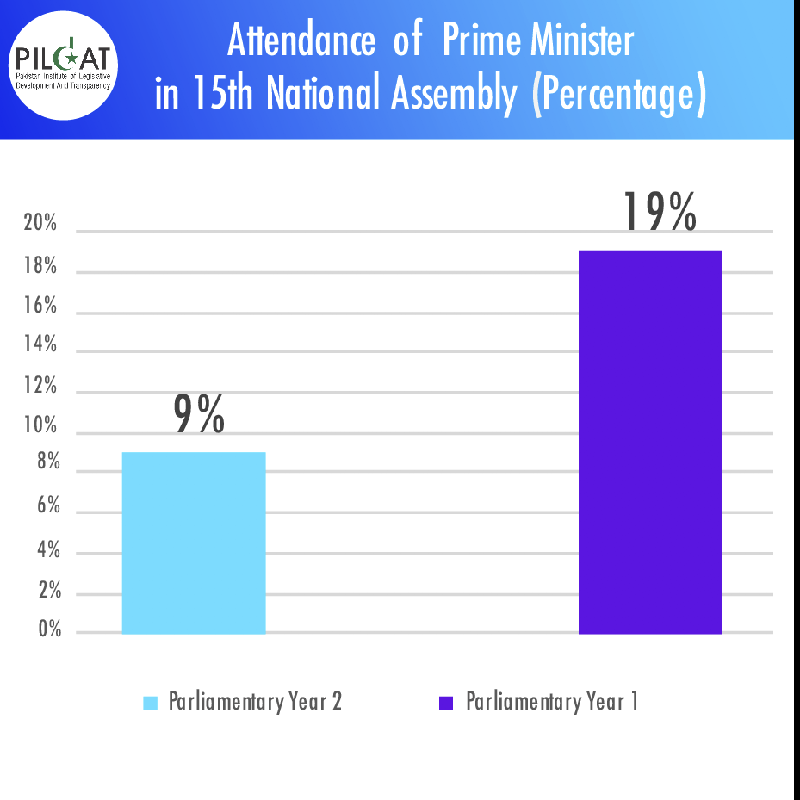
The 15th National Assembly, which has completed its two years out of the five-year tenure, made some progress in legislative performance but many concerning factors on its Key Performance Indicators (KPIs) still presist, according to a report published by Pakistan Institute of Legislative Development and Transparency (Pildat) on Thursday.
The detailed report reviewed the overall performance of the lower house of parliament including attendance of the prime minister, opposition leader and lawmakers during its two year period.
The 15th National Assembly has passed 3 times or 200% more bills than in the first year by passing 30 laws in the second year, compared to only 10 laws during the first year, read the report.

However, only 21 of these have been passed by both upper and lower house of parliament and received presidential assent to become Acts of Parliament.
Despite this increase in legislative activity, the PTI-led government has more frequently bypassed parliament during second year by promulgating 31 ordinances during the year. This is an approximately four-and-a-half times or 343% increase from the first year when the government had promulgated only 7 ordinances.

While passage of more legislations by the National Assembly should have been welcomed, the most problematic aspect of this legislative activity is that some of this legislation is not based on national indigenous initiatives to remove structural and procedural weaknesses and to improve democratic governance in Pakistan, the Pildat report said.
“Instead, the federal government has proposed and passed a number of bills or amendments to existing legislation based on commitments with the International Monetary Fund (IMF) or the action plan agreed with the Financial Action Task Force (FATF). This includes laws and amendments relating to State Bank of Pakistan (SBP), National Electric Power Regulatory Authority (Nepra), State-Owned Enterprise (SoE) law, and Anti-Money Laundering (AML).”
Attendance of prime minister
The report said PM Imran Khan’s attendance of the assembly sessions is another KPI, which remained at only 19% during year one and in need of improvement.
In second year, the PM’s attendance percentage has further plummeted by 55% as he only joined 8 out of 89 or meagre 9% sittings of the National Assembly.
“PM Imran’s commitment to regularly attend parliamentary sittings and personally answer questions once a week or fortnight, in line with British Parliamentary tradition, also remained unfulfilled,” the report added.

Attendance of leader of the opposition
On the other side of the aisle, attendance of the Leader of the Opposition in the National Assembly, Shehbaz Sharif, has also declined by 94% compared to the first year.
During the second parliamentary year, Shehbaz attended 3 out of 89 or only 4% sittings of the assembly, as opposed to 53 of the 96 or 56% sittings he had joined during year 1.
Attendance of MNAs
Overall average attendance of MNAs in the National Assembly proceedings has also seen a decline from 73% in year 1 to 64% in the second year, perhaps largely due to coronavirus pandemic.
Working days
The National Assembly has also met for fewer days in second year, possibly again due to coronavirus pandemic, compared to year 1. The actual working days at 89 during the second year, have nominally decreased by 7% from year 1 when the assembly had met for 96 days. The house should be commended for exceeding (140 days) the constitutionally required minimum (130 days) working days (inclusive of a 2-day breaks) despite the constraints imposed by Covid-19.
Working hours
An important KPI, working hours spent in each assembly sitting, has seen an increase of 31% from year 1. The 15th National Assembly has spent 43 additional working hours by putting in 340 hours and 34 minutes in its second parliamentary year compared to 297 hours and 18 minutes in the first parliamentary year. The average working hours in the second parliamentary year was 3 hours and 50 minutes per sitting as compared to 2 hours and 55 minutes per sitting in the first parliamentary year.
Budget session
The crucial budget session, which has been in desperate need of substantial reforms, has seen a slight increase in number of days and working hours utilised for budget scrutiny. During the second year, the lower house has spent 18 days, compared to 16 days in the first year, and spent 104 hours and 14 minutes, compared to 89 hours and 27 minutes spent in budget session in the first year.
1731570357-0/elon-musk-(1)1731570357-0-405x300.webp)
-(1)1717678110-0/Kendrick-(1)-(1)1717678110-0-165x106.webp)






1732428532-0/BeFunk_§_]__-(43)1732428532-0.jpg)








COMMENTS
Comments are moderated and generally will be posted if they are on-topic and not abusive.
For more information, please see our Comments FAQ